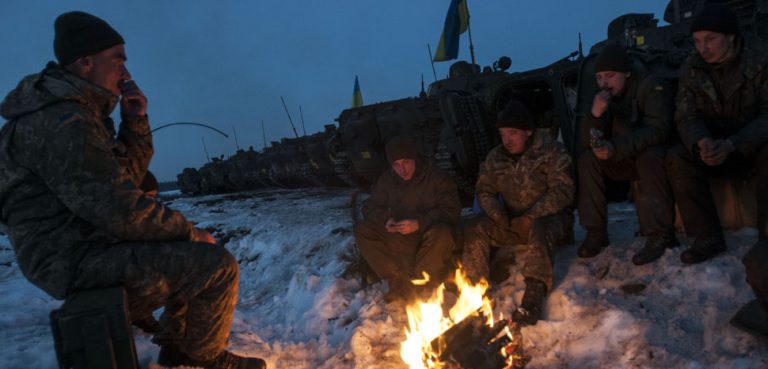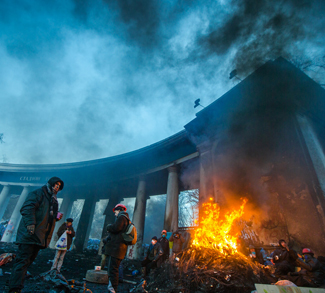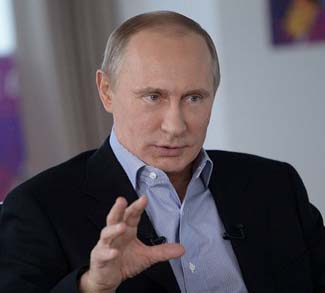World War III is underway. That’s the view of former Russia-watcher at the National Security Council Fiona Hill; though the consensus among most international security experts is that while President Vladimir Putin’s shameful and reckless invasion of Ukraine may have put us one giant leap closer to an all-out global conflict, we are not there yet. For now, these folks say, what we have entered is some sort of “Second Cold War”—although it appears that the “people of force,” or siloviki, the former and current members of the Russian security services who comprise Putin’s inner Kremlin circle, many of them, like Putin himself, cold hard veterans of the Soviet-era KGB, are playing according to the infamous “Moscow Rules” of the original Cold War. Have been all along. They simply picked up where the Soviet Union left off, with the United States and NATO cast as—in the lexicon of the old KGB, and those same siloviks still to this day—“the Main Enemy.”
It is this secret policeman’s prism, through which Russia’s leadership views the West, that successive U.S. and European leaders have failed to work into their own calculus over the last quarter-century, as they alternately teased and pursued an ad hoc, haphazard, ill-conceived, and dangerously risky expansion of NATO into what those same paranoid secret policemen in the Kremlin, Putin most of all—whether right or wrong, legitimate or otherwise—perceive as Russia’s own sphere of influence. Ukraine, with its complex cultural, historical, geopolitical and even territorial ties to Russia, was the last straw. Make no mistake, despite NATO’s somewhat inadvertently provocative policies and initiatives (again, from the Russian perspective), the responsibility for Russia’s actions in Ukraine, no matter how much they hem and haw about the indivisible security of European states while attacking one, lies solely with Vladimir Putin and his KGB henchmen. And although the White House has stopped short of saying as much—despite noting “the use of barbaric tactics” such as cluster bombs and missile strikes on civilian targets—what Putin and his forces are doing in Ukraine constitutes a war crime, perhaps several. Considering how the Kremlin prosecuted its own wars in Afghanistan (where Soviet forces scattered toys rigged with explosives to kill Afghan children), or Syria (where Russian aircraft indiscriminately bombed civilian population centers en masse), or against its own citizens in Chechnya (where our old pal Boris Yeltsin razed Grozny to the ground in a meat-grinder of a mission that Putin ruthlessly settled to the tune of tens of thousands of civilian deaths), it will come as no surprise if the Russians escalate their brutality as the situation on the ground becomes more desperate, especially in the event of a protracted insurgency involving the more merciless among Russia’s forces: various spetsnaz units and elements of the Kremlin’s main security services, the FSB and SVR. That the Russians have already reportedly bombed a Holocaust memorial to the victims of Babyn Yar—where the Nazis and local Ukrainian auxiliaries massacred over 30,000 Jewish men, women, and children in just two horrific days—is perhaps a frightening omen of things to come.
As former Director of the CIA and commander of Central Command, General David Petraeus, notes, the war is going terribly for Putin. So far, his forces have failed to achieve several key military and political objectives, including the overthrow of the Ukrainian government in Kyiv—much in part due to the inspirational, Churchillian leadership of President Zelensky and the steadfast courage of his people. But it’s early days yet, and Putin is already pouring more forces into his offensive, as a massive Russian armored column rolls towards Kyiv on the heels of a fresh airborne assault on Kharkiv. In his most threatening gesture to date, the Russian president has also put his nuclear forces on high alert, promising severe consequences if any NATO forces get involved in Ukraine. As ordinary Russians—and perhaps some in Putin’s own inner-circle—begin to feel the weight of crippling economic sanctions that have sunk the ruble and spiked the Russian interest rate, some television commentators have even called for “regime-change” inside Russia. Others have wisely advised caution. In the words of Council on Foreign Relations President Richard Haas, “A cornered Putin is a dangerous Putin.” General Petraeus makes the even finer point that it’s best not to make a guy with nuclear weapons feel like he has nothing left to lose.
And even if Putin were to fall without dropping “the Big One,” what would come in his place? Who, if anyone, would take over? An even harder line despot? A true totalitarian perhaps? (Russia may be the first secret police state in history run by the secret police; but in a truly Russian twist of irony, its people today possess more freedom, stability, and prosperity than at any time in their history, including under Yeltsin and Gorbachev—another reality the West must accept.) Or, without Putin, would the country simply plunge into a state of civil war, on a scale not seen since the Bolshevik Revolution, except this time with a nuclear arsenal of over 4000 warheads up for grabs? (Be careful what you wish for.)
This is why, now more than ever, it is imperative, that Western leaders collectively recognize the big picture errors of the last thirty years concerning NATO expansion and our engagement with Russia. Not to repudiate intent—which has always been to maintain an international rules-based order between democratic states and others, most of all nuclear-armed powers like Russia and China—but to best recalibrate our own decision-making process to minimize future risk and ensure better outcomes. Elite special operations units like Delta Force call this a “hot wash,” a debrief in the aftermath of a hostage rescue or direct action mission, whether a success or failure. In this case, an honest postmortem will allow nation-states to thoroughly assess the strategic consequences of any future foreign policy initiative before they implement it; and for that assessment to remain unspoiled by subjective group-think or reactionary partisanship, decision-makers themselves should readily be able to accurately recite any partner or adversary’s own outlook, perspective, and objectives—no matter how disagreeable, illegitimate, or outlandish—to better shape their own calculus; because by the time an invasion happens, it’s already too late. Diplomacy has failed.
Entertaining a sober assessment of Western foreign policy, including a hot wash of the last three decades of U.S./NATO-Russian relations, along with dispassionate consideration of the Russian perspective, even while accepting specific realities that may run contrary to certain U.S. or NATO initiatives but not overall interests, is neither foolhardy nor “treason,” as some of our more melodramatic (and hardly qualified) television pundits would have us believe (many of them from the same camp that for years ridiculed President Reagan for labeling the Soviet Union an “Evil Empire,” but now wish to do the same to modern Russia). This must remain an indispensable component of the foreign policy process, especially in the nuclear age. And that cuts both ways. Because perhaps if President Putin himself had stepped outside his own Kremlin echo chamber to properly consider the Western perspective, and the Ukrainian will, not to mention the true capability of his own armed forces, he might have realized the dangerous folly and global ramifications of an invasion that has clearly not gone to plan, but still promises to get much worse, and possibly spread elsewhere. Or maybe he doesn’t care. (Something else we should figure out.)
So, where do we go from here? How to confront this foe without putting his back too hard against the wall? Fight a war and keep the peace. As I forecast in my last piece, the invasion has afforded us the perfect jumping off point to mount an aggressive covert offensive against Moscow, and we can start with something akin to Operation Cyclone, the CIA-led program to arm the mujahideen during the Soviet war in Afghanistan, using civilian covert operators and contractors to offer the U.S. and NATO the necessary buffer of plausible deniability to prevent a direct clash between NATO and Russian forces.
If they haven’t already, the CIA and any other relevant intelligence agencies (DIA, NSA, NGA) should set up a joint “Russia House” to run an all-out “Great Game”-style worldwide shadow war against the Russians. They should already be pumping tons of human and other assets into Ukraine itself to: first, run “Operation Cyclone II” in the event that a long-lasting, protracted insurgency takes hold against Russian forces (which Putin will likely attempt to shatter with brute force); and second, run deep-cover clandestine operations against any puppet regime that Moscow manages to put in place, which will likely present a hardline military occupation and long-term martial law—in other words, a very hostile denied area. They should definitely try to make any insurgency last for as long as Russian forces operate outside the Donbas region, which, because it is more Russian-friendly, like the Crimea, presents a much more complex and difficult operating environment.
On a wider front, our security services need to work jointly to assess and undermine Russian forward projection efforts across the globe, including the Middle East, namely Syria; Africa, where Russian mercenaries have been operating in Libya, South Sudan, Mozambique and elsewhere; and Latin America, particularly Venezuela. On that note, the National Security Council should immediately put the wheels in motion to remove the leader of that country, Mr. Maduro, using assets out of Colombia and elsewhere. This would shock the Russians—along with the Chinese and Iranians who also operate there, a neat little hat trick to shore up security and reassert our strength in our own sphere of influence. (A nice bonus: It would also rattle the Cubans since Maduro is Havana’s favorite love child, and might eventually bring them back to the negotiating table on rapprochement, which would prove the ultimate coup de grâce on Russian influence in our backyard.)
Another bold move: bring Sweden and Finland into NATO. The issue of former Soviet republics, particularly Ukraine, joining the EU or NATO has always been understandably controversial, even if Western leaders—until now—seemed dismissive of the inherent complexities and potential aftershocks of merely entertaining the idea. But Sweden and Finland, while traditionally neutral, are both long-time Western-oriented democracies, and have none of the cultural or historic ties to Russia that Moscow holds over Ukraine (no Kievan Rus’ to claim as a birthright)—quite the contrary in the case of Finland, which endured both Russian imperialism in the tsarist era, and its brutal Winter War against the Soviets in tandem with World War II. Now that Russia has invaded Ukraine based on Putin’s newfound propensity for redrawing international borders at will, Finland certainly has legitimate reason to take out an insurance policy under NATO’s Article V umbrella. Swedish and Finnish membership would send a clear message to the Kremlin that engaging in hostilities against non-members, even former Soviet republics like Ukraine, will only make the alliance stronger in ways that the siloviki had not calculated. The only caveat is that all such decisions must be weighed, of course, against a sober assessment of Moscow’s potential reaction, and the nuclear question. Putin has already used WMD against his enemies on NATO soil—radioactive polonium once (in the UK) and Novichok twice (in the UK and Germany)—killing a former FSB man and an innocent British citizen in the process, while putting thousands of lives at risk. With every action from our own side, we must take seriously his threats to do so again, this time on a much larger scale.
For as long as Russian action in Ukraine continues outside the Donbas, the European powers must also continue pouring troops and weapons into Ukraine’s NATO neighbors: the Baltics, Poland, and Romania. No more slow-rolling. This is 1983 Berlin Wall/Checkpoint Charlie Pershing missile days all over again. That’s how the Russians have been playing it (and then some) for at least the last fifteen years, so it’s time we caught up.
If Putin employs a brute-force offensive to bolster his flailing invasion of Ukraine, he may take the country, but he will never pacify it. By confronting him with a precisely crafted mix of visible strength, covert aggression, and strategic diplomacy that nevertheless offers him “an out” from what still could end up as a quagmire beyond what the Soviets suffered in Afghanistan, we may at least be able to convince him to pull his forces back into the Donbas. From there, we can negotiate a further peace, though even then his lasting goal will likely be to fracture and fragment Ukraine into oblivion no matter what the cost.
The danger will remain.
Even under peace, we may always be at war.
Alex Holstein is the co-author of Warfighter: The Story of an American Fighting Man, due out May 15, 2022, from Lyons Press. He holds an MSc in Russian and Post-Soviet Studies from the London School of Economics, where he wrote his thesis on the Soviet KGB.
The views expressed in this article are those of the authors alone and do not necessarily reflect those of Geopoliticalmonitor.com




